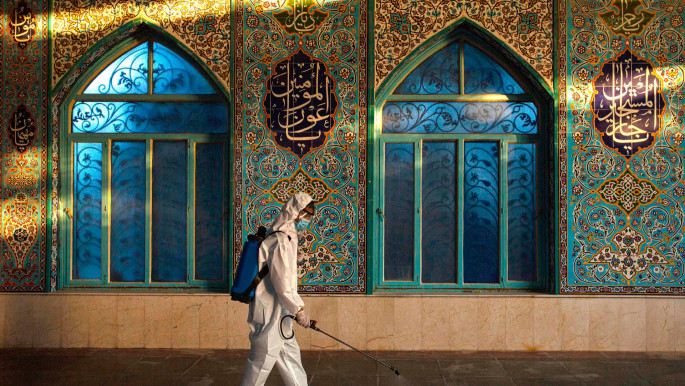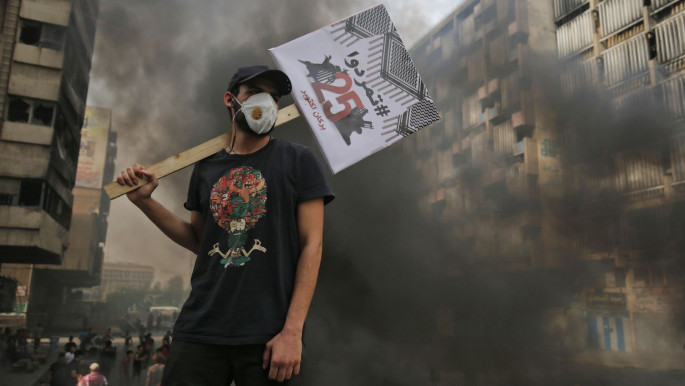Nowhere to go: Iraq's IDP camp closures leave thousands destitute
Hammam Al-Alil was one of the largest IDP camps in federal Iraq, hosting 1,836 families from the Nineveh region. It's now empty.
The closure was announced on 2 November and ten days later no more than 20 families remained. Since last Sunday, the camp is officially considered closed.
More than 8,580 people, including 5,000 children, are now scattered across the Nineveh plain, most of them without a place to go and at risk of becoming homeless.
"Authorities came and listed the place of origin for each family. For some destinations there were buses. Others just folded their tents and took to the road, without any money or a place to go," Marine Olivesi, a spokesperson for the Norwegian Refugee Council (NRC), the organisation managing Hammam Al-Alil, told The New Arab.
"We heard some families negotiating to sell their belongings in exchange for transportation. Some kept their tent saying it would be their last resource, planning to build it in some ruins or improvised new camps. We are afraid those makeshifts camps might become bigger".
 |
They said we have to go home. Home where? I don't have a place to go back to. My home is still destroyed |  |
Nowhere to return to
"They said we have to go home. Home where? I don't have a place to go back to. My home is still destroyed," despairs Lamya, displaced from Hatra, 100 kilometres from Mosul. "It came from one day to the other, we have no time to prepare anything," echoes Naheda, from Qayarah, in Mosul district.
 |
|
| Read more: Fighting fake news in Iraq's battle against Covid-19 |
Contacted by phone, both are mothers now displaced for a second time, with no idea what to expect. Widows of conflict in the region or men rejected by their community because of suspected former allegiances to the Islamic State (IS) "could wander for days without having access to water, shelter and basic needs," the NRC has said.
Many also fear for their safety in their former communities, with many still destroyed from the war against IS. According to the International Organization for Migration (IOM), 76 percent of IDPs who tried to go back home faced a second eviction from their place of resettlement.
Both the OIM and NRC are trying to keep track of the families through databases and surveys. "55 percent of families who left camps last week told us they would try to go home, 45 percent said they would go elsewhere," Olivesi says. But according to a previous survey that the NRC conducted in September in Hammam Al-Alil, three out of four people said that their former homes were still destroyed.
 |
For some destinations there were buses. Others just folded their tents and took to the road, without any money or a place to go |  |
Although the Iraqi government officially declared the defeat of IS in December 2017, the group remains active across the country with sporadic but deadly attacks. The most recent on 6 November saw IS militants attack a lookout point west of Baghdad manned by state-sponsored tribal groups, killing 11 people.
In the rest of Iraq, the situation is not much better. Camps around Karbala and Baghdad already closed last month. Around the capital, the closure of two small camps in the Sunni neighbourhood of Abu Ghraib (Shams and Al-Ahl) hosting 105 and 74 families, has resulted in the rise of informal small ghettos.
From mid-October, Iraqi authorities initiated the closure of 10 sites in Baghdad, Karbala, Diyala, Anbar, Nineveh and Kirkuk, and announced even more before the end of the year. In the few camps still open, the level of uncertainty is high. Salamiyah is the biggest IDP camp still open in Iraq. It hosts 2,366 households, more than 11,570 people, all from the Nineveh plain.
 |
|
| Read more: 'Resilience has its limits': The heavy toll of coronavirus on Iraq's displaced |
"According to the last information we have, Salamiyah will remain open until the beginning of 2021, but this could change again, maybe even today," a humanitarian worker in the camp told The New Arab. "The whole situation is very uncertain; we have zero formal communication and it's very hard for us to communicate on this matter to our beneficiaries".
What will happen to the IDPs if Salamiyah closes remains an unanswered question. "We have a database of their areas of origin, but due to the sensitive situation we don't know what they would do if they have to leave. Many people themselves don't know".
 |
Over 1.3 million people are still displaced in Iraq, according to aid groups |  |
Different government, same path
It is not the first time that the Iraqi government has decided to close IDP camps. Last year, thousands of families faced a similar situation when a first wave of camp closures occurred. Several assessments from NRC and UN sources show that families are being displaced several times, in a sequel of unsustainable and precarious solutions.
 |
|
| Read more: 'They are still trying to silence us': One year on, Iraq's youth rise again |
"They start by renting a flat, but then they finish the money and they end up squatting in unsanitary housing," Olivesi says. As in the past, the Iraqi government promised an allowance of around $1,200 per each family but surveys from last year show that more than 95 percent of those interviewed had not received any money.
It's hard to envision where the government will find the money to fulfil this promise, when public salaries have been delayed for the last two months and the country is sinking into an economic crisis.
Government sources explained the abrupt decision to close the camps as an incentive for international donations towards reconstruction in areas devastated by war across Iraq.
Mustafa al-Kadhimi's government, in place since May, has already announced its intention to close all camps before March 2021. According to the NRC, 1.3 million people are still displaced in Iraq.
More than 100,000 were living in camps in federal Iraq before the closures started, while 150,000 people are still living in camps across areas in the Kurdish Regional Government (KRG), which has not yet announced a schedule for closures.
Sofia Nitti is an Italian video journalist based in Baghdad, Iraq
Follow her on Twitter: @SofiaNitti





 Follow the Middle East's top stories in English at The New Arab on Google News
Follow the Middle East's top stories in English at The New Arab on Google News


